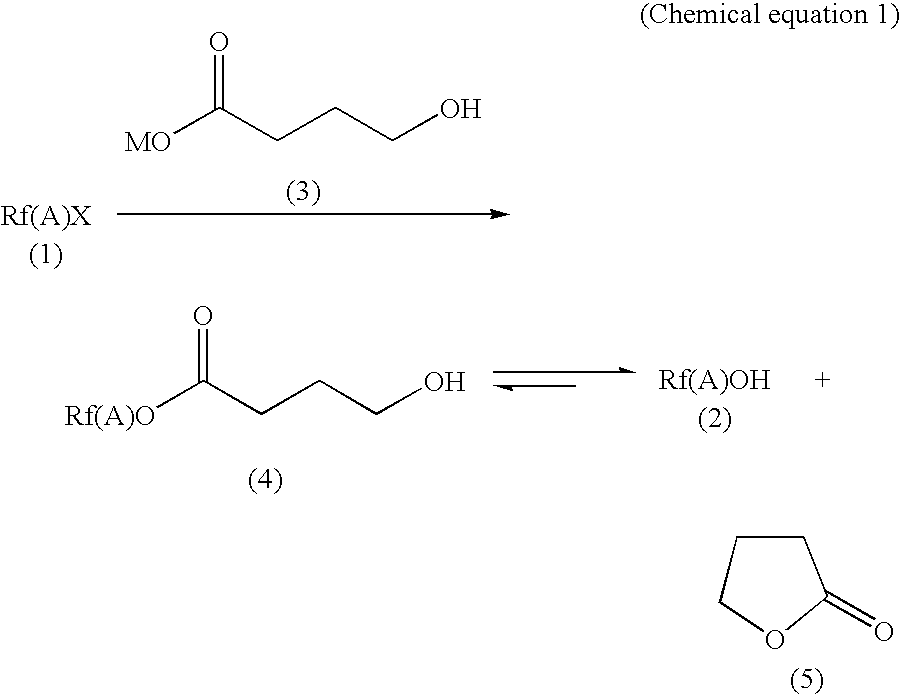Process for producing fluorinated alcohol
a technology of fluorinated alcohol and process, which is applied in the field of fluorinated alcohol production methods, can solve the problems of difficult isolation and purification of desired products, reduced alcohol yield, and inability to accept impurities even in trace amounts, and achieves high product yield, low cost, and high selectivity of desired fluorinated alcohol
- Summary
- Abstract
- Description
- Claims
- Application Information
AI Technical Summary
Benefits of technology
Problems solved by technology
Method used
Image
Examples
example 1
[0022]250 g gamma-butyrolactone, 62.5 g (440 mmol) potassium 4-hydroxybutyrate, and 95.2 g (400 mmol) 4,4,4-trifluorobutyliodide were placed in a 500 ml four-necked flask equipped with a stirrer, a reflux cooler, and a thermometer. By heating, the mixture was maintained at 75° C. for 5 hours while being stirred. At this point, it was determined by a gas chromatography that 98.6% of the 4,4,4-trifluorobutyliodide had been converted. Subsequently, the temperature was raised to 140° C. and the reaction was allowed to continue for another 2 hours. Upon completion of the reaction, the mixture was again analyzed by a gas chromatography. The results of the analysis revealed that 4,4,4-trifluorobutyliodide was converted at 100% conversion rate, and the selectivity for 4,4,4-trifluorobutanol, trifluorobutyl 4-hydroxybutyrate, and 4,4,4-trifluoro-1-butene were 86.5%, 13.3%, and 0.2%, respectively.
[0023]The reaction mixture was then subjected to distillation: it was transferred to a 500 ml fla...
example 2
[0024]In a 500 ml four-necked flask equipped with a stirrer, a thermometer, a Claisen connector tube, and a Liebig's cooling tube, 250 g gamma-butyrolactone was placed along with 51.4 g (440 mmol) of 48% aqueous solution of potassium hydroxide. To distill water, the mixture was heated to an inner temperature of 140° C. at a pressure of 20 kPa while being stirred. The mixture was then allowed to cool to approximately 50° C. and the pressure was brought back to atmospheric pressure. 95.2 g (400 mmol) 4,4,4-trifluorobutyliodide was then added to the mixture and the mixture was heated for 5 hours at 75° C. The results of a gas chromatography analysis indicated that 99.1% of 4,4,4-trifluorobutyliodide had been converted. The reaction temperature was then increased to 140° C. and the reaction was allowed to continue for another 2 hours.
[0025]Upon completion of the reaction, the mixture was again analyzed by a gas chromatography. The results of the analysis revealed that 4,4,4-trifluorobut...
example 3
[0026]The reaction was carried out in the same manner as in Example 1, except that the reaction was performed for 7 hours at 140° C. A gas chromatography analysis was performed when the temperature reached 140° C. and the results indicated that 85.5% of 4,4,4-trifluorobutyliodide had been converted by then. Upon completion of the reaction, the mixture was again analyzed by a gas chromatography, the results of which revealed that 4,4,4-trifluorobutyliodide was converted at 100% conversion rate, and the selectivity for 4,4,4-trifluorobutanol, trifluorobutyl 4-hydroxybutyrate, 4,4,4-trifluoro-1-butene, and bis(4,4,4-trifluorobutyl)ether were 85.3%, 12.3%, 0.2% and 2.2%, respectively.
PUM
| Property | Measurement | Unit |
|---|---|---|
| temperature | aaaaa | aaaaa |
| temperature | aaaaa | aaaaa |
| temperature | aaaaa | aaaaa |
Abstract
Description
Claims
Application Information
 Login to View More
Login to View More - R&D
- Intellectual Property
- Life Sciences
- Materials
- Tech Scout
- Unparalleled Data Quality
- Higher Quality Content
- 60% Fewer Hallucinations
Browse by: Latest US Patents, China's latest patents, Technical Efficacy Thesaurus, Application Domain, Technology Topic, Popular Technical Reports.
© 2025 PatSnap. All rights reserved.Legal|Privacy policy|Modern Slavery Act Transparency Statement|Sitemap|About US| Contact US: help@patsnap.com

